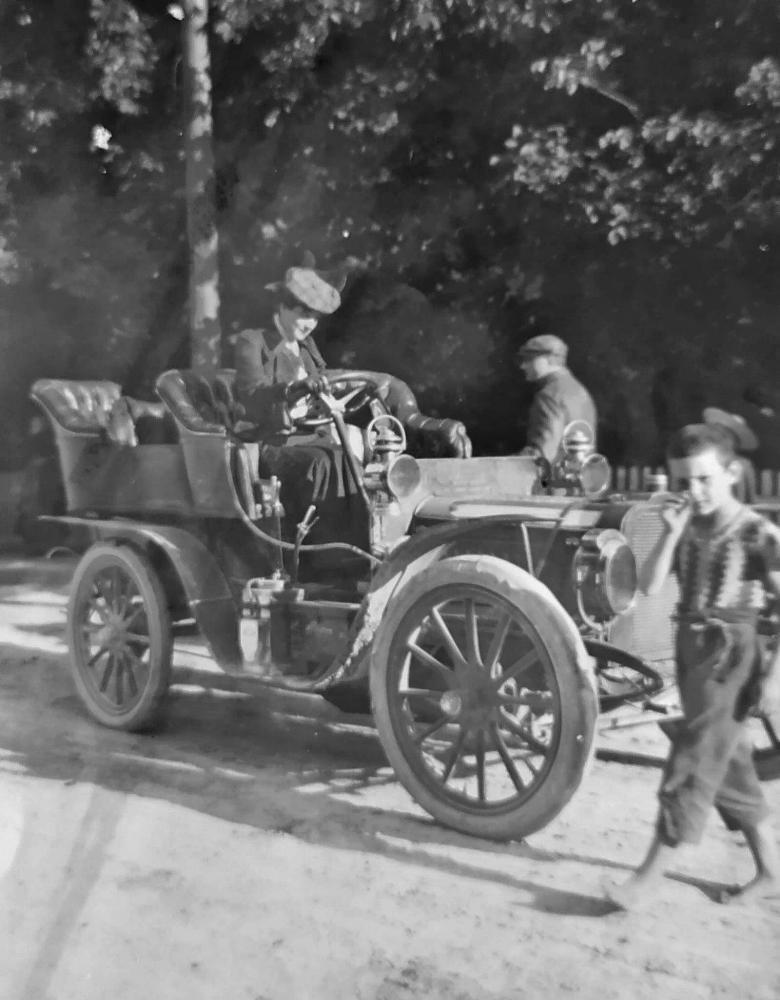***
Italian automobile car history early years
The Italian Automotive Industry: Early Years
Figure 1.-- en in Lizzano, Apulia region, in the early-20th century. We are not sure what model this was. Notice the leather upolstry. Cars at the time were built for the well-to- do. The car probably came from the nearby city of Taranto. While the photographer took the photographh a boy walked in front. Cars at the time were not all that common in the cities, outside the cities they were rare and attracted a lot of attention.
The Italian automoble industry began in the late-19th century. Enrico Bernardi built a gasoline-fueled tricycle (1884). Stefanini-Martina was the first manufacturer (late-1880s). Giovanni Battista Ceirano started building Welleyes bicycles (1888). He decided an English name provided an up-scale image. The Turin car cluster played a key role. 【Enrietti, et. al.】 Ceirano formed a joint venture with his brothers Matteo, and Ernesto to build the Welleyes motor car -- Ceirano GB & C (1898). The brothers quickly encountered financial problems. A consortium of well-heeled local nobility and businessmen led by Giovanni Agnelli purchased the Welleyes operation including the designs and patents (1899). The consortium was the Fabbrica Italiana Automobili Torino (FIAT). Their first car was Fiat 3 ½ HP. They produced eight cars. 【Anonymous】 The Welleyes/FIAT 4 HP had a 679 cc engine and was capable of 22 mph. Isotta Fraschini opened a plant (1900). They produced the first Renault. Other plants soon followed, including, Aquila Italiana, Fratelli Ceirano, Societé Anonima Italiana Darracq - Darracq, Diatto, Itala, Junior, Lancia, Societé Ceirano Automobili Torino, STAR, Rapid, SPA, and Zust. These were all small operations essentially craft shops producing small numbers of high-priced for wealthy individuals. FIAT won the first of its many victories in automobile racing. Vincenzo Lancia, won the Torino Sassi-Superga (1902). Anonima Lombarda Fabbrica Automobili (ALFA) which became Alfa Romeo was founded (1910). Basic and technical education was important in early developments. 【
Enrietti, et. al.】 We see the many small producers manufacturing large, prestigious, luxury vehicles. While many of the early Italian cars were trechnically sound, no Italian company was trying to produce really low-cost cars for the public. The Fiat Balilla was the lowest price Italian pre-War car, but hardly something that workers could even dream of purchasing. Of course, the major factor here was that Italian workers were so poorly paid that they could not afford to buy cars. Wages in the north approached European levels, but many in southern Italy were outside the monied economy. This was essentially the worst situation for any of the major Europpean powers.
Sources
Anonymous. "Italian cars history," Life in Italy (May 15, 2019).
Enrietti, Aldo, Aldo Geuna, Consuelo R Nava, and Pier Paolo Patrucco. "The birth and development of the Italian automotive industry (1894–2015) and the Turin car cluster," Industrial and Corporate Change Vol. 31, Issue 1 (January 2022), pp. 161–85.
HBC
Navigate the Children in History Web Site:Main early automotive industry page ]Main Italian automotive industry page ]Main autmobile page ]About Us ][Introduction ]
[Biographies ]
[Chronology ]
[Clothing ]
[Disease and Health ]
[Economics ]
[Environmental issues ]
[Feminism ]
[Geography ]
[History ]
[Human Nature ]
[Law ]Nationalism ]
[Presidents ]
[Religion ]
[Royalty ]
[Science ]
[Social Class ]Bibliographies ]
[Contributions ]
[FAQs ]
[Glossaries ]
[Images ]
[Index ]
[Links ]
[Registration ]
[Search ]
[Tools ]
Children in History Home ]


